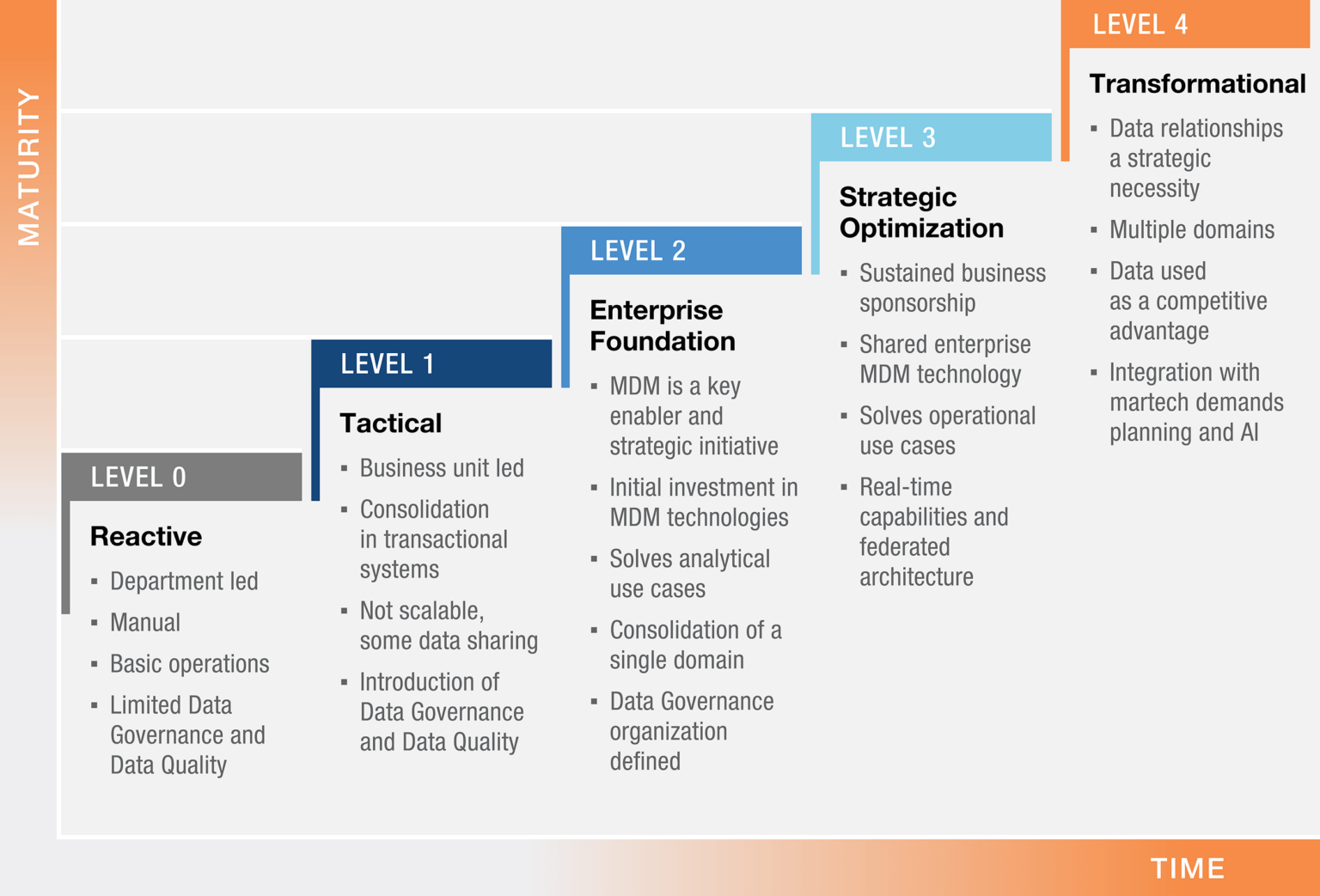Introduction
In an era where data is heralded as the new oil, the capacity to manage, interpret, and leverage this valuable asset determines an organization’s competitive edge and operational efficiency. The concept of Data Maturity Models emerges as a pivotal framework, guiding businesses through the complex landscape of data management. It’s not just about collecting data; it’s about cultivating an environment where data drives strategic decision-making and innovation.
Many organizations grapple with challenges that stem from an immature data management strategy.
These range from the tangible—such as inefficient data utilization and poor data quality. It continues to the strategic, like ad-hoc decision-making and a lack of comprehensive governance. The consequences are significant, manifesting as missed opportunities, reduced operational efficiency, and a compromised ability to compete in a data-driven marketplace.
Data Maturity Models, particularly in the realm of Master Data Management (MDM), offer a structured pathway to elevate an organization’s data handling capabilities. They illuminate the journey from rudimentary, reactive measures to a strategic, optimized utilization of data. However, understanding these models and their relevance can sometimes be an abstract endeavor. How does one identify where their organization stands on this spectrum? More importantly, how can they navigate the path to a higher level of data maturity, reaping the benefits of a refined, data-led strategy?
Data Maturity Models: Table of Contents
What is a Data Maturity Model?
A Data Maturity Model provides a framework to assess and guide the enhancement of an organization’s data management capabilities. It acts as a compass, helping businesses navigate the often tumultuous journey from data chaos to clarity. Fragmented information silos transform into a unified, strategic asset. What exactly does this model entail and how does it serve the vast ecosystem of Master Data Management (MDM)?
Data Maturity Models are constructed around multiple dimensions and can include data quality, governance, integration, and utilization. They are not limited to only these dimensions though. Data maturity models allow organizations to evaluate their current stage of data management. From there, they identify the steps required to progress towards a more sophisticated, data-driven operation. This progression is typically segmented into various levels. Each one is characterized by specific capabilities, tools, practices, and strategic orientations toward data.
5 Key Areas to Understand in Master Data Management
In the context of Master Data Management (MDM), the Data Maturity Model shines a spotlight on five key areas:
- Business Alignment: The degree to which data management objectives are synchronized with the organization’s strategic goals.
- Automation/Tools: The extent of technological support and automation in managing data across the enterprise.
- Use Cases: Practical applications and scenarios that leverage master data to drive business value.
- Architecture: The structural design of data systems and processes, ensuring they support comprehensive, efficient data management.
- Data Quality/Data Governance: The practices and policies in place to maintain high-quality, reliable data throughout its lifecycle.
By assessing an organization’s maturity in these areas, the MDM Maturity Model serves as both a diagnostic tool and a strategic guide. It highlights current weaknesses. It provides a clear improvement plan with achievable milestones over a period, typically spanning one to three years. This roadmap is crucial for organizations to prioritize initiatives, allocate resources effectively, and set realistic expectations for growth and optimization of their MDM programs.
Moreover, the model facilitates a structured approach to developing a data management strategy that aligns with company initiatives. For instance, if an organization is contemplating an ERP migration or consolidation, the MDM Maturity Model would advocate for the deduplication and cleansing of customer contact and product information in MDM systems prior to the migration. Such strategic actions ensure that the new platform is seeded with clean, consolidated data. This ultimately enhances the outcomes of the migration effort.
Understanding and implementing a Data Maturity Model within the MDM framework enables organizations to manage their data and strategically leverage it as an integral business operation. It transforms data from a passive resource into an active, strategic asset. It drives decision-making, operational efficiencies, and competitive advantage in the market.
Why Data Maturity Matters
The journey towards data maturity is not just a technical endeavor. It is a strategic imperative that impacts every facet of an organization’s operations. The significance of achieving a higher level of data maturity extends beyond the mere optimization of data management processes. It is a high level function because it is about harnessing data as a powerful, strategic asset. This can drive business success in five profound ways.
1. Improved Decision-Making
The journey towards data maturity is not just a technical endeavor. It is a strategic imperative that impacts every facet of an organization’s operations. The significance of achieving a higher level of data maturity extends beyond the mere optimization of data management processes. It is a high level function because it is about harnessing data as a powerful, strategic asset. This can drive business success in five profound ways.
2. Process Optimization
As organizations progress in their data maturity, they unlock the potential to streamline operations and improve efficiency. Mature data practices allow for the automation of routine data tasks, reduction in manual errors, and the elimination of redundant processes. This optimization is important because it reduces operational costs but also frees up valuable resources to focus on strategic initiatives that drive business growth.
3. Enhanced Data Quality and Governance
Achieving higher data maturity levels inherently involves improving data quality and governance. This means implementing policies and practices that ensure data accuracy, consistency, and security across the organization. High-quality, well-governed data reduces risks, complies with regulatory requirements, and builds trust with customers and stakeholders. This is important because it supports high operational efficiency.
4. Competitive Advantage
In today’s data-driven world, an organization’s ability to effectively manage and leverage its data can be a significant competitive differentiator. Companies with mature data practices are better positioned to identify market trends, understand customer behaviors, and respond to competitive threats more swiftly. This agility and insight can be pivotal because it supports capturing market share and driving business success.
5. Innovation and New Opportunities
Lastly, mature data management practices lay the foundation for innovation. By effectively leveraging data, organizations can uncover new opportunities for product development, market expansion, and customer engagement. Data maturity enables businesses to experiment and innovate with confidence. This is important because it gives an organization a deep understanding of their operational landscape and market dynamics.
In conclusion, the importance of data maturity transcends the technical realm because it embeds itself deeply within the strategic fabric of an organization. It is a critical enabler of operational excellence, strategic agility, and competitive prowess. As such, investing in the journey towards higher data maturity is not just about improving data management. It’s about securing the future success and sustainability of the organization because that is what truly makes an impact.

The Levels of Data Maturity
Delving into the intricacies of the Data Maturity Model and Master Data Management (MDM) unveils a structured progression through various levels of maturity. Each level represents a significant phase in an organization’s journey to harness data as a strategic asset. Here’s a breakdown of these levels, highlighting the distinct characteristics and strategic imperatives at each stage.
Reactive MDM - Level 0
At the inception, organizations often find themselves in a Reactive state, where data management is sporadic and uncoordinated. There’s no dedicated budget or alignment with business strategies, and data consolidation is a manual, ad-hoc process. The primary focus is on extinguishing immediate fires rather than strategic data planning. Moving forward from this level involves recognizing the need for structured data management, developing a business case for MDM, and securing executive buy-in and budget.
Tactical MDM - Level 1
Progressing to Tactical MDM, organizations begin to see parts of the enterprise acknowledging the importance of MDM. Data consolidation efforts might be automated within transactional systems, but they’re not scalable or fully integrated. Data remains siloed, and deduplication efforts are recognized but not enterprise-wide. Advancing from tactical to strategic data management requires acknowledging the need for an enterprise MDM solution and integrating data governance practices.
Enterprise Foundation - Level 2
At Enterprise Foundation, MDM is recognized as a strategic initiative and business leaders and CXOs advocate for its integration into other business programs. Investment in MDM technologies grows, focusing on data consolidation, integration, and quality management. This level sees the initiation of third-party data enrichment and cleansing, laying the foundation for analytics and business intelligence. The challenge here is to maintain momentum and continue aligning MDM initiatives with broader enterprise goals.
Strategic Optimization - Level 3
Strategic Optimization marks a phase where the foundational elements of MDM are leveraged for analytics and business intelligence, moving towards a more operational use across the enterprise. There’s sustained business sponsorship, and MDM technology is shared enterprise-wide. The focus shifts to optimizing these initiatives, integrating master data with operational systems, and recognizing information as an asset across the organization. The goal at this level is to maximize the value derived from MDM by expanding its application and ensuring its alignment with enterprise strategies.
Transformation - Level 4
Finally, Transformation represents the pinnacle of data maturity, where the organization fully realizes the strategic value of MDM. Data management tools and practices are sophisticated and embedded across the enterprise, focusing on identifying and leveraging data relationships. This level is characterized by a strategic necessity to connect data domains, using MDM to drive competitive advantage and support complex use cases like AI applications and demand planning. Not every organization needs to reach this level, but for those where it aligns with strategic goals, the focus is on deepening the integration of data management practices to drive innovation and strategic advantage.
Understanding and navigating the levels of data maturity is essential for organizations aiming to leverage data as a strategic asset. Each level presents unique challenges and opportunities, with strategic imperatives that must be addressed to progress to the next stage. The journey through these levels is not linear or one-size-fits-all; it requires a tailored approach that aligns with the organization’s specific goals, industry context, and operational dynamics. By methodically advancing through these levels, organizations can transform their data management practices, achieving a state where data not only supports but drives strategic decision-making and competitive differentiation.
Building a Roadmap to Data Maturity
Embarking on the journey toward higher data maturity requires a strategic, structured approach. Organizations must not only understand where they stand in the maturity spectrum but also chart a clear path forward. This is especially important to build a roadmap. Building a roadmap to data maturity involves several critical steps, each designed to guide organizations through the complexities of enhancing their data management capabilities.
1. Assess Current Maturity Level
The first step is to conduct a thorough assessment of the current state of data management within the organization. This involves evaluating practices, technologies, and strategies against the levels of the Data Maturity Model. Identify the characteristics that define your organization’s current level and pinpoint areas of strength and those requiring improvement.
2. Define Your Data Vision
Establish a clear, strategic vision for what you want to achieve with your data. This vision should align with the organization’s overall strategic objectives and define what success looks like in terms of data management. Consider factors such as decision-making, operational efficiency, customer experience, and innovation. Your data vision will serve as the guiding star for your maturity journey.
3. Identify Gaps and Opportunities
With a clear understanding of your current maturity level and a vision for the future, the next step is to identify the gaps between these two points. This involves pinpointing the specific areas within your data management practices, technologies, and governance that need enhancement. Concurrently, identify opportunities where improvements in data management can drive tangible business value.
4. Set Priorities and Milestones
Given the broad scope of data management, it’s essential to prioritize initiatives based on their impact on the organization’s goals and the effort required. Develop a phased approach, setting realistic milestones and timelines for achieving specific objectives. This phased approach should balance quick wins that demonstrate value early with long-term strategic initiatives that require more significant investment and transformation.
5. Develop an Implementation Plan
Translate your priorities and milestones into a detailed implementation plan. This plan should outline the projects and initiatives required to close the identified gaps, including the adoption of new technologies, processes, and governance frameworks. Assign responsibilities, allocate resources, and establish metrics for tracking progress against each milestone.
6. Foster Organizational Alignment and Buy-in
Achieving data maturity is not solely the responsibility of the IT department; it requires broad organizational alignment and support. Engage stakeholders across the business to ensure there is a shared understanding of the importance of data maturity and the role it plays in achieving strategic objectives. Secure executive sponsorship to drive change and ensure adequate resources are allocated.
7. Continuously Monitor and Adapt
Finally, recognize that the journey to data maturity is iterative and ongoing. Continuously monitor progress against your roadmap, adapting plans as necessary based on the changing business environment, technological advancements, and organizational learning. Celebrate milestones to build momentum and reinforce the value of the journey.
Building a roadmap to data maturity is a strategic imperative that can significantly enhance an organization’s ability to leverage data as a competitive asset. By methodically assessing the current state, setting a clear vision, and developing a phased plan for improvement, organizations can navigate the complexities of data management transformation. The journey requires commitment, collaboration, and continuous adaptation, but the rewards in terms of decision-making, efficiency, and innovation are well worth the effort.
Choosing the Right Model for Your Organization
As organizations journey towards higher data maturity, one critical decision point is selecting the appropriate data maturity model that aligns with their specific needs, goals, and operational context. While the path to data maturity is universal in its importance, the nuances of how it’s navigated can significantly vary between organizations. Here’s a guide to making this pivotal choice, ensuring the selected model acts as a true catalyst for data-driven transformation.
Understand Your Unique Data Landscape
Every organization operates within a unique data landscape, shaped by its industry, size, market position, and strategic objectives. Begin by conducting a comprehensive review of your data ecosystem—this includes data sources, storage, management practices, and usage across the organization. Understanding the details of your data landscape will highlight specific challenges and opportunities, guiding the selection of a maturity model that addresses your unique needs.
Align with Strategic Objectives
The chosen data maturity model must tightly align with your organization’s strategic objectives. Whether you’re focused on improving customer experience, optimizing operations, driving innovation, or all of the above, the model should provide a roadmap that supports these goals. It should facilitate not just the management of data, but its transformation into a strategic asset that propels your organization towards its long-term vision.
Evaluate Model Flexibility and Scalability
The dynamic nature of the digital business environment demands flexibility and ability to scale in any strategic framework. The right data maturity model for your organization should be adaptable, able to evolve with your changing needs and the shifting technological landscape. Consider how the model accommodates growth, integration of new data sources, and the adoption of emerging technologies like AI and machine learning.
Consider Organizational Culture and Capability
The effectiveness of a data maturity model can have limits because it is also contingent on your organization’s culture and existing capabilities. Assess if your team is ready to embark on this journey. Include technical skills and look at organizational willingness to embrace change and adopt a data-centric mindset because both will play a part in the overall process. The right model should match your current capabilities. Proper alignment is important because it can help push your organization to grow with a realistic path forward that doesn’t burden your team.
Seek Examples of Success in Similar Contexts
Learning from the experiences of others is important because it can provide valuable insights into the potential fit of a data maturity model. Look for case studies or examples of organizations in similar industries or with similar challenges that have successfully navigated their data maturity journey. This can offer practical evidence of the model’s applicability and effectiveness in contexts akin to your own.
Conclusion
In the dynamic landscape of modern business, data has emerged as a cornerstone of success because it ultimately helps with better decision making. Organizations that effectively manage and leverage their data assets gain a competitive edge. They seek this because it supports driving innovation, operational efficiency, and strategic decision-making. The journey towards data maturity is a strategic imperative, guiding organizations from reactive data practices to strategic data excellence.
We’ve explored the intricacies of data maturity models because it’s important within the realm of Master Data Management (MDM). From understanding the importance of data maturity to navigating the levels of maturity and building a roadmap for progress, we’ve outlined key principles and strategies to guide organizations on this transformative journey.
As you embark on your own path to data maturity, remember that success requires not just a technical approach but a strategic mindset. It’s about aligning data management practices with broader organizational goals because we want to foster a culture of data-driven decision-making so we can continue to evolve to meet the demands of the digital age.
At Infoverity, we specialize in guiding organizations through the strategic implementation of data maturity models. With our expertise in Master Data Management and a deep understanding of industry best practices, we partner with businesses to unlock the full potential of their data assets. Whether you’re just beginning your journey or seeking to optimize your existing data management practices, we’re here to support you every step of the way.
Contact us today to learn more about how Infoverity can help elevate your organization’s data maturity and drive meaningful business outcomes through strategic data management.


